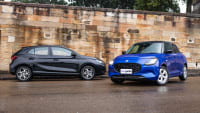If you’re the kind of person who still hasn’t gotten their head around DVD players, and you prefer your technological advancements to arrive at the speed of a tortoise rather than a hare, the concept of hydrogen cars may cause you to pine for the days when penny-farthings ruled the roads.
Vehicles powered by hydrogen may sound like something intimidating beamed in from the future, but it’s a transport technology that’s been around for far longer than you’d actually think.
Who made the first hydrogen car?
The first internal-combustion-engined (ICE) vehicle to be powered by hydrogen looked more like a torture device than something that could reliably get you places, and it was created by Swiss inventor Francois Isaac de Rivaz in 1807, utilising a balloon filled with hydrogen, and oxygen. Technically you could call it the first hydrogen car, although the first modern hydrogen-powered vehicle wouldn’t arrive until 150-plus years later.
The history of hydrogen fuel cells

Back when life was chill enough for the average person to have three jobs at once (that’d be 1847), chemist, lawyer, and physicist William Grove invented a working fuel cell, aka a device that converts the chemical energy of hydrogen and oxygen into electricity, thus giving him bragging rights as the fuel cell inventor.
Fuel cell history was made when Groves’ work was expanded upon by English engineer Francis Thomas Bacon between 1939 and 1959, with the first modern fuel cell vehicle being an Allis-Chalmers farm tractor that had been kitted out with a 15kW fuel cell in the late 1950s.
The first road vehicle to use a fuel cell was the spiffily named Chevrolet Electrovan, which arrived in 1966 from General Motors and boasted a range of close to 200km, and a top speed of 112km/h.
Hydrogen was primarily used as a fuel source for Space Shuttles in the 1980s and ’90s, but by 2001, the first 700 Bar (10000 PSI) hydrogen tanks came into play - a game changer as the tech could be used in vehicles, and extend the driving range.

The late-2000s and early 2010s were a boom time for hydrogen cars being gently launched into the global marketplace. In 2008, Honda launched the FCX Clarity, which was available for lease to customers in Japan and Southern California, although it was relegated to the big carpark in the sky in 2015.
Around 20 other hydrogen-powered vehicles were released in either prototype or demo form, including the F-Cell hydrogen fuel cell electric vehicle (FCEV - not ‘FCV’, as some people label it) from Mercedes-Benz, the HydroGen4 from General Motors, and the Hyundai ix35 FCEV.
Hydrogen cars: what’s available, what’s coming soon
Hyundai Nexo

The case for hydrogen-powered cars as a viable transport option got a boost when, in 2018, Hyundai released the Nexo in Korea, where it has sold 10,000-plus units, and costs the equivalent of $AU84,000.
The Nexo has also been on sale in the US (in the eco-friendly state of California), the UK, and Australia, where it has been available for special lease to the Government and big business since March 2021, making it the first ever FCEV to be made commercially available on our shores.
Currently the only place to refuel the Nexo in NSW is at Hyundai HQ in Sydney, although there is a semi-public hydrogen refuelling station located in Canberra, where the Government has leased a number of hydrogen FCEVs.
Onboard hydrogen gas storage can handle 156.5 litres, with the Nexo capable of a driving range of 666km on electric motor outputs of 120kW/395Nm.
Refuelling the Nexo - and all hydrogen cars - pleasingly takes only a few minutes, which is a major advantage over electric vehicles, which take anywhere from 30 minutes to 24 hours to charge.
Toyota Mirai

The first generation Mirai FCEV hit Japan in 2014, and the recently released second-generation version has already made a media splash by setting a world record in traveling 1,360km on a full tank of 5.65kg of hydrogen.
Like Hyundai, Toyota hopes that hydrogen refuelling infrastructure in Australia will rapidly roll out so that it can sell its FCEV to consumers, with leased Mirais in Australia only currently able to top up at one Toyota-owned location in Altona, Victoria.
Onboard hydrogen gas storage is 141 litres, and driving range is 650km.
H2X Warrego

Aussie FCEV start-up H2X Global will start deliveries of its hydrogen-powered Warrego ute in April 2022.
The before-on-road-costs price tags aren’t for the faint of heart: $189,000 for the Warrego 66, $235,000 for the Warrego 90, and $250,000 for the Warrego 90 XR.
Onboard hydrogen tanks come as either 6.2kg (500km range) or 9.3kg (750km range).
Also…
.jpg)
A Hyundai Staria FCEV is in the works, as well as FCEVs from Kia, Genesis, Ineos Automotive (the Grenadier 4x4) and Land Rover (the iconic Defender).
.jpg)
.jpg)

.jpg)
.jpg)
.jpg)









_0.jpg)
.jpg)



.jpg)



